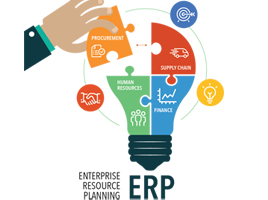
The evaluation process is critical to the success of enterprise resource planning systems, and is one way IT can bring real value to your company’s finance department.
Management can’t make informed decisions without financial clarity. To deliver financial clarity, serve investors, manage taxes and fulfill other requirements, large organizations employ armies of financial analysts and accountants. Too often, those professionals struggle with aging applications that deliver inadequate data and reports. IT leaders have the opportunity to support controllers, CFOs and other finance leaders with better technology.

Understanding what finance departments want from ERP
Finance managers require up-to-date systems and technologies to perform several aspects of their jobs, and IT must understand finance’s needs in order to choose the right ERP system. Here are three priorities that the finance department will likely expect ERP systems to address.
1. Keeping pace with enterprise growth.
As organizations grow in complexity, ERP systems and the finance function need to keep pace. For example, if the organization has recently gone through a major acquisition or business change, an older ERP system may not be equipped to adjust to the new reality. “The early approach to ERP was to bake process into the software. That worked well for many years. Now the world has changed and those fixed processes no longer work without supplemental processes,” says Keith Mattioli, principal in KPMG’s Enterprise Solutions practice.
2. Minimizing reliance on error-prone spreadsheets.
Despite the large sums spent on ERP systems and other types of business software each year, many critical finance functions are still completed with bespoke Microsoft Excel spreadsheets. These files frequently lack traditional IT or project management controls to ensure quality, and that can lead to problems. In 2013, The Telegraph reported that “poor spreadsheet protocols” were primarily to blame for estimated $5.8 billion in trading losses that JP Morgan racked up in 2012 from credit default swaps. And according to CNBC, a study by U.K. financial advisory firm F1F9 found that 88 percent of all spreadsheets have errors in them — including many spreadsheets used by large organizations that ought to know better.
“CFOs are starting to realize that manual processes and spreadsheets simply do not scale to meet new business challenges,” says Mattioli. “Manual processes also pose risk and governance challenges for finance.”
3. Improving analytics and business intelligence.
The CFO and the finance department are expected to produce business cases, budgets and other reports that are based on high-quality data and solid information processing. Unfortunately, the data often comes from a variety of sources that vary considerably in quality. New ERP software may improve the finance department’s analytics and business intelligence capabilities.
But before you initiate a discussion about an ERP upgrade, remember that finance departments tend to have risk-adverse cultures that prize accuracy and timely production. In that spirit, it is important to engage with finance at the right time. Avoid starting discussions about significant improvements or changes during quarter- or year-end cycles. Asking for a big picture conversation with a finance professional working to meet a deadline will undermine the connection.
Evaluating new ERP options: Price, flexibility and BI
Cloud-based ERP systems and software-as-a-service offerings can be good options if you’re concerned about price, or if you want a flexible system that can provide business intelligence (BI) capabilities.
“The low initial investment is a key benefit of [SaaS-based] ERP products,” says Eric Kimberling, managing partner at Panorama Consulting, an ERP consulting firm based in Denver. “I see a large number of small organizations adopt cloud-based ERP solutions, and a small number of large organizations.”
However, perceived security risks prevent some large companies from moving financial systems to the cloud. “Finance is a core company function that cannot fail — that’s one of the reasons why finance has been slow to adopt cloud services,” says Mattioli. Lost or corrupted financial data may expose a company to tax and regulatory sanctions. And under the Sarbanes-Oxley law, executives of public companies face potential prison time if financial statements are incorrect.
But providers of hosted ERP tools are themselves to make the security of their customers’ data a priority. “SaaS providers can go out of business if they fail to deliver, so they have strong incentives to deliver a secure and reliable service,” Kimberling says.
Flexibility and BI capabilities are other important features to look for in a new ERP system. “A growing number of cloud-based ERP systems enable business transformation and business intelligence,” says Mattioli. IT has an important role in evaluating these suppliers and determining if their offerings will fit with existing technology. “These benefits are important because there are limits to what can be achieved with cost reduction,” he adds.
How to add value to finance with technology
Data quality is absolutely essential with financial systems. And processes and training — both of which likely fall under IT’s purview — are as important as the technical capabilities of the software itself when it comes to ensuring data quality. Making sure that best practices are in place may be a new challenge for ÌT groups that have traditionally built one-off solutions in response to requests from business users, according to Mattioli. “It is important to have difficult discussions about simplification and look at the bigger picture,” he says.
Use the following three approaches to help the finance division get the most out of its ERP technology:
1. Data quality management
Take the time to assess how well the company is organizing and carrying out data management. A visualization tool such as Tableau is often useful to identify anomalies. “Hyperion is a popular business intelligence tool, and IT can facilitate configuring it effectively,” says Kimberling.
2. Business process improvement
IT’s traditional strength in business process mapping and improvement should come into play when supporting the finance department. “Ineffective or outdated charts of accounts drive major problems for finance departments: IT may be able to help implement solutions to these problems,” says Kimberling. Modelling how finance produces a quarterly forecast or annual budget is an excellent starting point.
3. Audit support and tracking
Maintaining accurate records regarding financial transactions is important. IT can add value to this process by maintaining robust identity and access management controls. Budgets and other financial documents are frequently subject change over the course of ongoing business activities, so tracking how decisions are made is important.
Remember that auditors are rarely impressed if a company responds to their queries by saying, “Our system does not track that.” Controls make a difference in achieving “clean” audit results. Finance needs to be able to withstand audits and audit-like inquiries from internal auditors, external auditors and management.
The way forward for finance and IT
Senior executives rely on financial data to make effective decisions. Supporting finance leaders starts by understanding their world and their needs: the pain of manual processes, the need to deliver accurate reports to critical audiences and the importance of enabling managers to make smart decisions. Current and aspiring IT leaders can also learn from their peers in finance who have developed robust reporting and analytical skills. Building these relationships will ensure that IT is at the table and taken seriously when decisions about ERP systems and other financial technologies are contemplated.





















